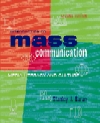|
 |  Introduction to Mass Communication, 2/e Stanley J. Baran
What's NewKey Changes to the Second Edition:
-
Reorganized Internet coverage to reflect the pervasive influence the Internet has had on all other media. The Internet chapter (formerly 14) is now covered in Part I (Chapter 3). It now provides a stronger foundation for coverage of convergence in all the medium chapters.
-
An expanded and refined definition of media literacy to include the work of James Potter and Alan Rubin. The "Media Literacy Primer" has been moved to Chapter 3 to provide a stronger foundation.
-
Expanded material on alternative media includes: low power radio, P2P systems (Gnutella, Napster, Freenet), and Zines.
-
Chapter 15 is now more focused on the globalization of the media industries with special attention paid to issues of Cultural Imperialism.
-
New Cultural Forum boxes highlight key issues related to the effects of media on society. These include: The Passing of the Independent Bookseller; Whose Life Is It Anyway: Protecting Personal Privacy in the Digital Age; Will We Accept Dogme Dogma? (about an alternative-anti-Hollywood-approach to filming); The Ford and Firestone Debacle.
-
New Using Media to Make a Difference boxes include: Our Bodies, Ourselves; Covering the Issue of Race; Rock 'n Roll, Radio, and Race; and Maintaining Gross National Happiness.
-
All statistical entries updated. These changes include a new discussion of Internet demographics; new media consumption statistics; new statistics for all media sales and circulation figures.
-
Media Ownership: Changes (as much as possible) reflect mergers and changes in media conglomerate ownership.
|
|
|



 2002 McGraw-Hill Higher Education
2002 McGraw-Hill Higher Education

 2002 McGraw-Hill Higher Education
2002 McGraw-Hill Higher Education